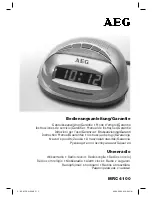
Specifications
Quiescent condition indicator
Flashing red LED every 40 s
Expected battery life
10 years
205-008: 5 years
Low battery indication
Short audible signal every 40 s, synchronized with
a single flash of the red LED, for 30 days
Low battery hush indication
Flashing red LED every 20 s
Low battery hush time
10 h
Sounder output level
≥
85 dB @ 3 m
Alarm sounder
0.5 s on / 0.5 s off
Alarm LED indicator
Flashing red every 1 s
Alarm hush indication
Flashing red LED every 1 s
Interconnected units
: Flashing red LED every
6 s
Alarm hush time
9 min
Test sounder
(0.5 s on / 0.5 s off
Test LED indicator
Flashing red every 1 s
Interconnected units
: Flashing red every 40 s
Heat sensor fault indication
Short audible signal every 40 s
and a single flash of the red LED midway
between the audible indications
Fault hush indicator
Flashing red LED every 20 s
Fault hush time
10 h
Interconnection
(Model 205-008)
No device number limit
500 m between all devices in free air
Operating temperature
(0 ~ +55) °C
Operating humidity
(10 ~ 95) % RH, non-condensing
Compatibility
The 205-008 interconnectable heat alarm is compatible with the following
devices.
Description
Part number
Datasheet
Smoke alarm, wireless interconnect
205-002
31-0047
Smoke/heat alarm, wireless interconnect
205-011
31-0095
Accessories
The following accessories are compatible with 205-008 DC heat alarms with
wireless interconnection.
Description
Part number
Datasheet
Alarm remote control
261-001
31-0084
Compliance
205 heat alarms are designed to comply with the following standards
a
.
BS 5446-2:2003
Fire detection and fire alarm devices. Specification for heat alarms
CE
Conformité Européenne
a
Third-party conformance assessment has not been undertaken.
Installation Preparation
Equipment
Before commencing installation, ensure all equipment and tools to mount and
test the device are available, such as drills, mounting screws (supplied),
cables and ladders.
Location Selection in Homes and Apartments
Heat alarms are suitable for residential applications where smoke or gas
detectors may cause unwanted alarms. The following locations are suitable for
heat alarms.
•
Areas where combustion particles are present, such as kitchens with few
windows or poor ventilation.
•
Garages where there may be vehicle exhaust fumes.
•
Near furnaces, combustion heaters, and space heaters.
•
Damp or very humid areas, such as bathrooms with showers.
•
In an environment of between (0 ~ +50) °C, and (10 ~ 90) % relative
humidity (non-condensing).
•
Dusty or dirty areas.
•
Insect-infested areas.
WARNING
: Hazardous levels of smoke and toxic gas can build up
before a heat alarm might operate. Where life safety is the primary
requirement in the event of a fire, smoke, gas or combination alarms usually
provide earlier warning than heat alarms alone.
For complete coverage, smoke alarms should be installed in all rooms, halls,
storage areas, basements, and attics in dwellings. The minimum coverage is
one smoke alarm on each floor and one outside each sleeping area.
Installation Location
Install heat alarms as close to the centre of the ceiling as possible, away from
light fittings and air-conditioning ducts. If this is not practical, mount the heat
alarm on the ceiling, no closer than 50 cm from any wall or corner (see Fig. 1).
Fig. 1 – Heat alarm location from
walls
If some of your rooms have sloped, peaked, or gabled ceilings, try to mount
smoke alarms 0.9 m measured horizontally from the highest point of the ceiling.
Where
Not
to Install Your Heat Alarm
Heat alarms are not a suitable substitute for smoke alarms required in sleeping
areas.
Installation and Test
Please read the previous section
Installation Preparation
, before commencing
installation.
Install the Heat Alarm
WARNING
: To avoid the electrical shock hazard, turn off power to the
area where you plan to install the device at the fuse box or circuit
breaker box.
1.
At the place where you are going to install the unit, draw a 75 mm
horizontal line.
2.
Remove the unit from its base by rotating it counter-clockwise.
3.
Place the base on the ceiling so that mounting-hole slots are aligned on
the line. In each of keyhole slots, draw a mark to locate the mounting
plugs.
4.
Remove the base from the ceiling.
5.
Drill two 5 mm holes at the marks and insert the plastic mounting plugs
(supplied).
6.
Attach the base to the ceiling with the screws supplied (see Fig. 2).
Fig. 2 – Fixing the base
7.
Align the unit with the base rotate it clockwise to lock it into place (see
Fig. 3).
Note: Fitting the unit to its base internally connects the battery power to the unit.
Fig. 3 – Fitting the heat alarm to the base
Activate the Heat Alarm
1.
To activate your heat alarm, press and hold the Test/Hush button for 3 s
until the LED flashes rapidly.
2.
Once the LED starts flashing, release the Test/Hush button within 3 s.
The unit will emit a short beep to indicate that it is activated.
Wireless Interconnection Function (Model 205-008)
Long Alignment Mark
Short alignment mark
Fire
From
Smoke
Heat &
Ceiling
Best
Here
50cm min.






















